Home / Contents / Donations / News / Contact
DNB - Dunbar’s Number

Supports:
Context:
The Dunbar’s Number theory, proposed by British anthropologist Robin Dunbar, suggests a limit to the number of people with whom one can maintain stable social relationships—relationships in which an individual knows who each person is and how each person relates to every other person. In the context of DAOs, this concept translates to optimizing group size for effective communication, trust, and collaboration.
Problem:
Large groups often face challenges in maintaining cohesion and mutual cooperation due to overwhelming communication overhead and diminishing interpersonal relationships. This leads to inefficiencies and a diluted sense of community and accountability.
Forces:
- Scalability vs. Community Feel: As DAOs scale, they need to maintain a strong community feeling and effective governance despite their increasing size.
- Communication Overhead: Larger groups can lead to increased complexity in communication, reducing clarity and increasing organization noise.
- Trust and Accountability: In excessively large groups, individual accountability may decrease, and trust can be harder to establish and maintain.
Solution:
Implement a structure within the DAO where the number of active participants in decision-making and collaborative processes does not exceed Dunbar’s Number, approximately 150 individuals. This can be achieved through the establishment of smaller working groups or sub-committees that handle specific tasks or projects. Each group can operate semi-autonomously but still align with the DAO’s overarching goals and values.
Therefore:
Keep team sizes within the DAO around or below 150 to optimize collaboration, trust, and communication. Empower smaller groups to make decisions quickly and effectively, reporting back to the larger community to maintain alignment and coherence with the overall DAO objectives.
Supported By:
